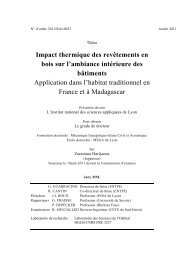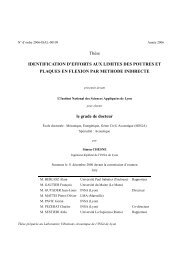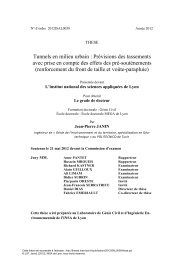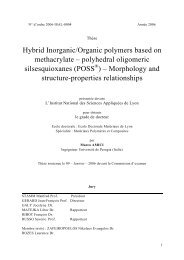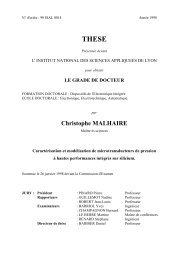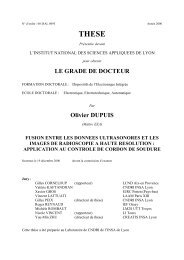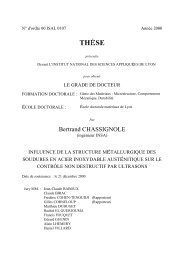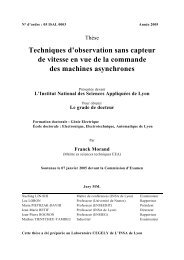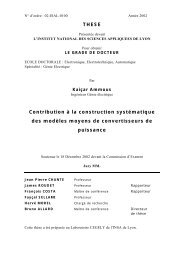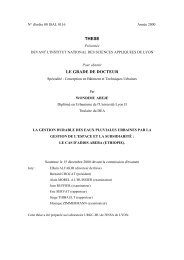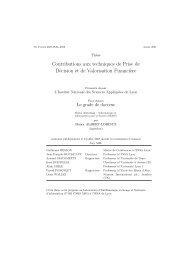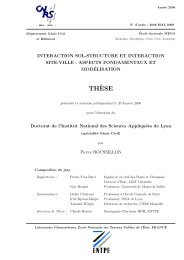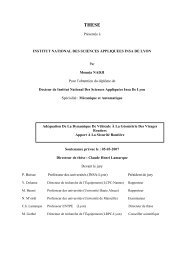- Page 1 and 2: N° d‟ordre : 2009-ISAL-0120 Ann
- Page 3 and 4: Remerciements - 3 -
- Page 5 and 6: Table des matières Résumé ......
- Page 7 and 8: VIII.1 Introduction ...............
- Page 9 and 10: Nomenclature (par ordre d’apparit
- Page 11 and 12: w teneur en eau sous conditions de
- Page 13 and 14: Les études menées récemment dans
- Page 15 and 16: VI). Pour terminer la revue bibliog
- Page 17 and 18: PARTIE I : ETUDE BIBLIOGRAPHIQUE -
- Page 19 and 20: moment, notamment par extraction de
- Page 21 and 22: II.1.1.5 La production de déchets
- Page 23 and 24: Figure II-3 : Composition moyenne n
- Page 25 and 26: (carbone, acide chlorhydrique et fl
- Page 27 and 28: traiter mais ne permet pas la stabi
- Page 29 and 30: - Stockage en mode bioréacteurs :
- Page 31 and 32: II.2.1.3 Gestion des émissions de
- Page 33 and 34: pour améliorer sa dégradation. La
- Page 35 and 36: géotextile en traversant la couche
- Page 37 and 38: Dans le cas de la conception des ba
- Page 39 and 40: Chapitre III : Les matériaux utili
- Page 41: On distingue ainsi quatre groupes (
- Page 45 and 46: - L’espace interparticulaire sép
- Page 47 and 48: - Gonflement cristallin de la montm
- Page 49 and 50: valence des ions présents. Plus la
- Page 51 and 52: Figure III-10 : Modes d'association
- Page 53 and 54: III.3 Système bentonite-eau-additi
- Page 55 and 56: Г (mg/g) représente la quantité
- Page 57 and 58: Figure III-15 : a) Adsorption de la
- Page 59 and 60: Chapitre IV : Les lois d’écoulem
- Page 61 and 62: volume des vides initiaux équivaut
- Page 63 and 64: w q P P argile w ( P P ) argile P a
- Page 65 and 66: Où Jm représente le flux de mati
- Page 67 and 68: h w z P w (IV-26) Le gradient hydra
- Page 69 and 70: Mitchell et Younger, 1967; Miller e
- Page 71 and 72: IV.5.2.4 La porosité La porosité
- Page 73 and 74: percolants ont été tirés avec de
- Page 75 and 76: - La difficulté de prévision des
- Page 77 and 78: - des matériaux argileux de forte
- Page 79 and 80: conditions, il serait donc plus ind
- Page 81 and 82: Où K Na-Ca est le coefficient de s
- Page 83 and 84: La vitesse d‟échange des ions su
- Page 85 and 86: esponsables du retardement des poll
- Page 87 and 88: V.4.1.3 Hydrogénocarbonate L‟att
- Page 89 and 90: V.4.2.5 Sodium Le sodium est, parmi
- Page 91 and 92: Mustafa et Hamid (1975) ont étudi
- Page 93 and 94:
VI.4.2 Traitement par ajout de poly
- Page 95 and 96:
L‟insertion d‟une bande en Téf
- Page 97 and 98:
VII.3 Œdoperméamètre La détermi
- Page 99 and 100:
poursuivre l‟essai de perméabili
- Page 101 and 102:
VII.4.3 Perméamètre à carottier
- Page 103 and 104:
PARTIE II : ETUDE EXPERIMENTALE - 1
- Page 105 and 106:
IG : valeur de gonflement pour 2g d
- Page 107 and 108:
Parmi les ions analysés, les deux
- Page 109 and 110:
Les Figure VIII-4 et Figure VIII-5
- Page 111 and 112:
Figure VIII-8 : Distribution des ca
- Page 113 and 114:
- compactage statique avec lequel u
- Page 115 and 116:
Passant(%) 100 90 80 70 60 50 40 30
- Page 117 and 118:
E : Numéro d‟échantillon w n :
- Page 119 and 120:
Alther et al. (1985) ont étudié l
- Page 121 and 122:
Ces résultats montrent aussi l‟a
- Page 123 and 124:
Figure IX-4:Evolution de l’IG et
- Page 125 and 126:
Figure IX-6: Indice de gonflement l
- Page 127 and 128:
Figure IX-8 : Influence de la conce
- Page 129 and 130:
Figure IX-10 : Influence de l’ajo
- Page 131 and 132:
Figure IX-12 : Evolution du pH en f
- Page 133 and 134:
- l‟influence de l‟ajout de pol
- Page 135 and 136:
Les propriétés du lixiviat synth
- Page 137 and 138:
Razakamanantsoa et al., 2009). Ces
- Page 139 and 140:
des expérimentations sur différen
- Page 141 and 142:
A : section du matériau (m 2 ); V:
- Page 143 and 144:
Les résultats montrent que le gonf
- Page 145 and 146:
X.4.4 Synthèse de l’étude de la
- Page 147 and 148:
Figure X-7 : Etalonnage du piston e
- Page 149 and 150:
Tableau X-3 : Récapitulatifs des c
- Page 151 and 152:
Figure X-9 : Oedoperméamètre en c
- Page 153 and 154:
Dans l‟ensemble ces deux objectif
- Page 155 and 156:
Figure X-11 : Cinétique des flux e
- Page 157 and 158:
Tableau X-5 : Paramètres caractér
- Page 159 and 160:
Figure X-15 : Ratio de gonflement d
- Page 161 and 162:
m 3 /m 2 /s, 4,39 x 10 -10 m 3 /m 2
- Page 163 and 164:
o Conductivité hydraulique déduit
- Page 165 and 166:
o Type d’appareillage Cette parti
- Page 167 and 168:
Chapitre XI : Performance hydrauliq
- Page 169 and 170:
H : la charge hydraulique e : épai
- Page 171 and 172:
Bouazza, (Bouazza et al. 2009), ava
- Page 173 and 174:
XI.2.2 Performance hydraulique Pend
- Page 175 and 176:
Tableau XI-1:Caractéristiques des
- Page 177 and 178:
XI.2.3.1 Influence de la concentrat
- Page 179 and 180:
grâce à la capacité d‟expansio
- Page 181 and 182:
cas lorsque le fluide est trop agre
- Page 183 and 184:
Tableau XI-4: Récapitulatifs des r
- Page 185 and 186:
Chapitre XII : Durabilité hydrauli
- Page 187 and 188:
Figure XII-4: Conductivité hydraul
- Page 189 and 190:
porosité et une baisse de site dis
- Page 191 and 192:
XII.4.4 Résultats et analyses Les
- Page 193 and 194:
l‟augmentation de la résistance
- Page 195 and 196:
Dans le domaine de faible perméabi
- Page 197 and 198:
même temps et de prendre en compte
- Page 199 and 200:
Les échantillons ont été décong
- Page 201 and 202:
XIII.4 Exploitation des résultats
- Page 203 and 204:
Afin de pouvoir estimer la quantit
- Page 205 and 206:
Figure XIII-9:Proportion cumulée d
- Page 207 and 208:
Figure XIII-11: Proportion des cati
- Page 209 and 210:
Les deux modes de représentation d
- Page 211 and 212:
XIII.4.3 Suivi de l’évolution de
- Page 213 and 214:
Figure XIII-15: Evolution des écha
- Page 215 and 216:
XIII.4.3.6 Conclusions L‟analyse
- Page 217 and 218:
Figure XIII-19 : Evolution des éch
- Page 219 and 220:
Figure XIII-21:Evolution des échan
- Page 221 and 222:
Figure XIII-22 : Description schém
- Page 223 and 224:
La comparaison des potentiels ioniq
- Page 225 and 226:
cations solubles sont tous disponib
- Page 227 and 228:
La recherche des indicateurs de dur
- Page 229 and 230:
GSB reconstitué, composé de bento
- Page 231 and 232:
géomatériaux renforcés semble ê
- Page 233 and 234:
d‟indicateur repose sur les dange
- Page 235 and 236:
Barast, G., Razakamanantsoa, A., Dj
- Page 237 and 238:
Chao, T.T., Harward, M.E., Fang, S.
- Page 239 and 240:
Gouy, M. G., (1910). “Sur la cons
- Page 241 and 242:
Le Pluart, L., (2002). “Nanocompo
- Page 243 and 244:
Rand, B., Pekenc, E., Goodwin, J.W.
- Page 245 and 246:
Weiss, A., Frank, R., (1961). “Ü
- Page 247 and 248:
NF P94-071-1 Août 1994 Sols : reco



